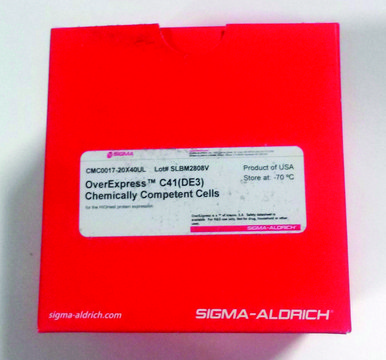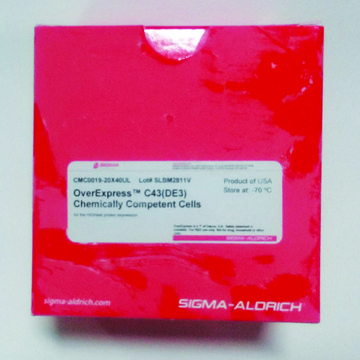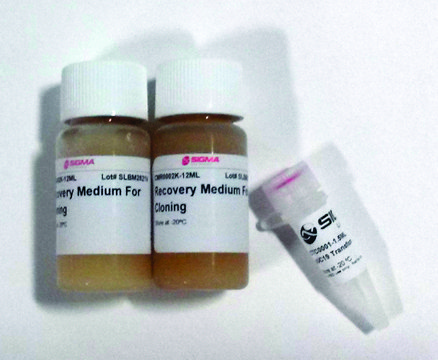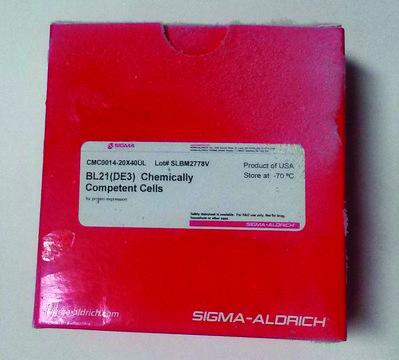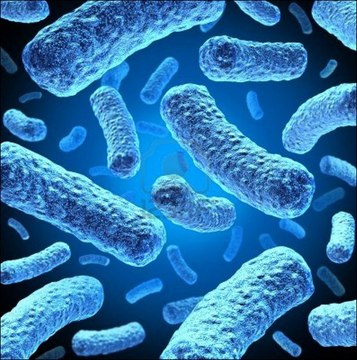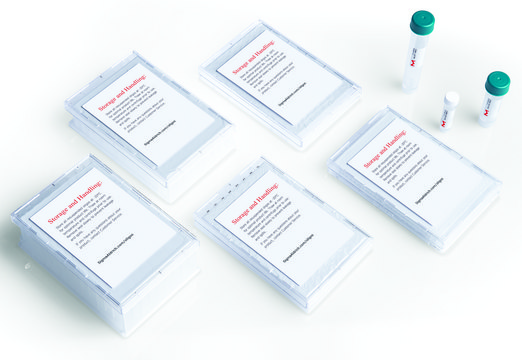推荐产品
产品名称
OverExpress™ C41(DE3) pLysS Chemically Competent Cells, for the highest protein expression
生物来源
Escherichia coli
等级
Molecular Biology
生长模式
adherent or suspension
形态学
rod shaped
技术
microbiological culture: suitable
细胞转化
competent cell type: chemically competent
transformation efficiency: ≥1 x 106 cfu/μg
运输
dry ice
储存温度
−70°C
一般描述
OverExpress™ Electrocompetent and Chemically Competent Cells are E. coli strains that are effective in expressing toxic proteins from all classes of organisms, including eubacteria, yeasts, plants, viruses, and mammals. The effectiveness of these new strains in expressing toxic proteins has been validated in more than 350 publications. The OverExpress™ strains contain genetic mutations phenotypically selected for conferring tolerance to toxic proteins. The strain C41(DE3) was derived from BL21(DE3). This strain has at least one mutation, which prevents cell death associated with expression of many recombinant toxic proteins. The strain C43(DE3) was derived from C41(DE3) by selecting for resistance to a different toxic protein and can express a different set of toxic proteins to C41(DE3). OverExpress C41(DE3)pLysS and C43(DE3)pLysS also carry a chloramphenicol-resistant plasmid that encodes T7 lysozyme, which is a natural inhibitor of T7 RNA polymerase. Cells containing pLysS produce a small amount of T7 lysozyme. These strains are used to suppress basal expression of T7 RNA polymerase prior to induction, thus stabilizing recombinants encoding particularly toxic proteins.
Genotype
F – ompT hsdSB (rB- mB-) gal dcm (DE3) pLysS (CmR)
Genotype
F – ompT hsdSB (rB- mB-) gal dcm (DE3) pLysS (CmR)
特点和优势
- Express genes cloned into any T7 vector with these BL21(DE3) derivatives
- Effective in expressing toxic & membrane proteins
- Cited in over 350 research articles
组分
- OverExpress C41(DE3) pLysS chemically competent cells
- pUC 19 transformation control DNA
- recovery medium for expression
法律信息
OverExpress is a trademark of Imaxio, S.A.
相关产品
产品编号
说明
价格
储存分类代码
10 - Combustible liquids
法规信息
新产品
Ji-Young Youn et al.
Molecular biology of the cell, 21(17), 3054-3069 (2010-07-09)
BAR domains are protein modules that bind to membranes and promote membrane curvature. One type of BAR domain, the N-BAR domain, contains an additional N-terminal amphipathic helix, which contributes to membrane-binding and bending activities. The only known N-BAR-domain proteins in
Myles B C Dillon et al.
ACS chemical biology, 7(7), 1198-1204 (2012-04-18)
Protein arginine methyltransferases (PRMTs) catalyze the posttranslational methylation of arginine using S-adenosylmethionine (SAM) as a methyl-donor. The PRMT family is widely expressed and has been implicated in biological functions such as RNA splicing, transcriptional control, signal transduction, and DNA repair.
Myles B C Dillon et al.
The Journal of biological chemistry, 288(39), 27872-27880 (2013-08-16)
Protein arginine methyltransferase (PRMT) 8 is unique among the PRMTs, as it has a highly restricted tissue expression pattern and an N terminus that contains two automethylation sites and a myristoylation site. PRMTs catalyze the transfer of a methyl group
Neale Harrison et al.
PloS one, 9(11), e113007-e113007 (2014-11-26)
N-acylethanolamines are an important class of lipid signaling molecules found in many species, including the nematode Caenorhabditis elegans (C. elegans) where they are involved in development and adult lifespan. In mammals, the relative activity of the biosynthetic enzyme N-acyl phosphatidylethanolamine-specific
实验方案
Protocol for OverExpress™ Chemically Competent Cells. Product Numbers: CMC0017, CMC0018, CMC0019, CMC0020, CMC0023, CMC0024
我们的科学家团队拥有各种研究领域经验,包括生命科学、材料科学、化学合成、色谱、分析及许多其他领域.
联系客户支持